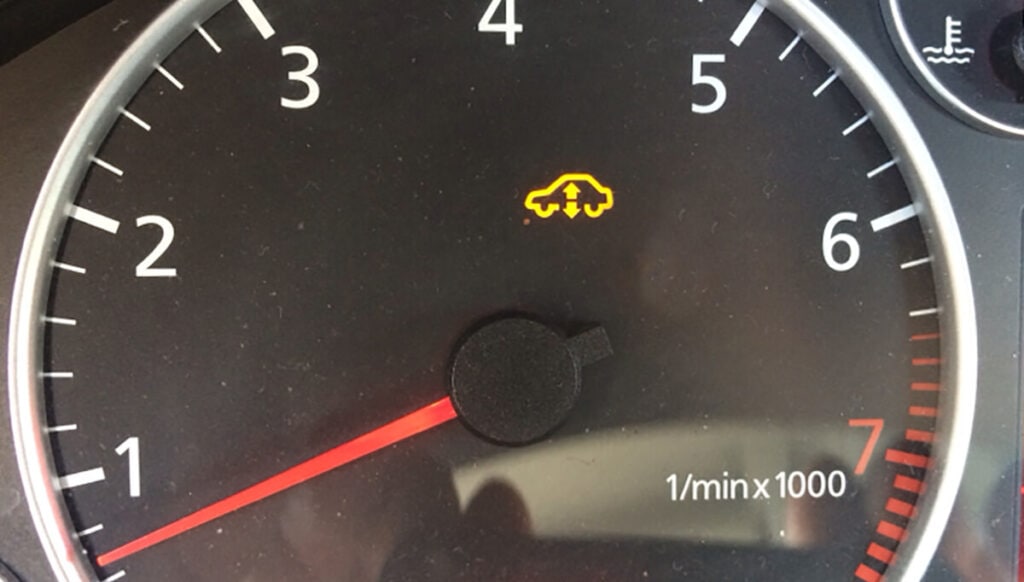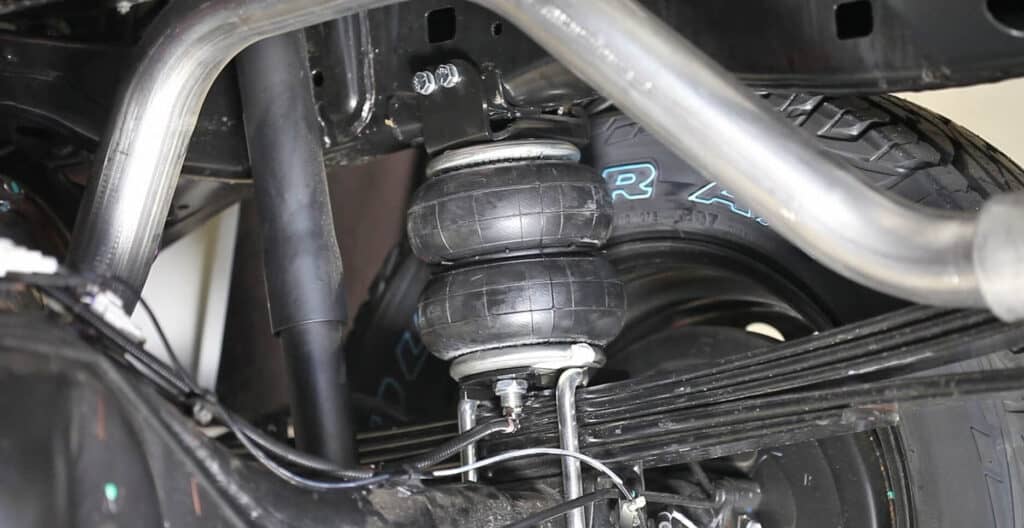Soaring on Air – The Magic and Mechanics of Air Suspension
A smooth drive isn’t just about the quality of roads or the type of car you own. Often, it’s the magic of the air suspension system that elevates your driving experience, quite literally. These systems, which have undergone technological evolutions, provide that coveted cushiony ride, keeping the roughness of the terrain at bay and wrapping you in vehicular comfort.
Lighting Up Your Dash: Recognizing the Air Suspension Warning Icon
We’ve all been there: a mysterious symbol suddenly pops up on the dashboard, leading to a series of frantic searches to decipher its meaning. Among these myriad icons, there’s one that’s particularly pivotal for vehicles equipped with air suspension. This icon typically showcases a car silhouette, accentuated by wavy lines beneath it, symbolizing the air cushion. Its illumination is your vehicle’s way of communicating that all is not well in its buoyant world.
Recognizing this specific warning light is imperative for any driver. Its presence is a signal that the vehicle’s comfort and safety systems might be at risk. The sooner a driver can identify this sign, the quicker they can take remedial action. Whether it’s consulting the vehicle’s manual, seeking expert advice, or driving to the nearest service center, being familiar with this icon can save both time and money in the long run, ensuring that the vehicle continues to offer that plush, cloud-like ride we’ve all grown to love.

Up in the Air: Unearthing the Causes Behind the Illuminated Warning
While your car might feel like it’s floating on a cloud, several complex components ensure this seamless experience:
• Complex System Mechanics: Air suspensions aren’t just about air. They encompass a network of sensors, valves, and compressors, all working in harmony to adjust the car’s height and counteract road imperfections.
• Wear and Tear: Like any mechanical system, prolonged use and time can gradually erode the components. Seals may deteriorate, and airbags can get tiny punctures, resulting in a reduced system efficiency.
• Sensor Failures: Modern cars rely heavily on sensors to regulate and adjust the air suspension. A malfunctioning sensor can falsely trigger the warning light or fail to detect a genuine issue.
• System Leaks: One of the most common culprits behind the warning light. A leaking air strut or bag can deplete the system of its pressurized air, impeding its ability to maintain the vehicle’s height.
• Compressor Issues: The heart of the system. A malfunctioning compressor can’t supply the necessary air to the struts or bags, leading to an underinflated system and an illuminated warning.
• Valve Blockages: Dirt or debris can occasionally obstruct the valves, preventing the system from adjusting air pressure effectively.
• Recalibration Needs: Sometimes, the solution is straightforward. Due to jolts, bumps, or system updates, the sensors might need recalibration to function accurately.
• Electrical Glitches: Given the electronic components integrated into the system, a simple electrical fault, like a blown fuse, can also light up the warning indicator.
• Adverse Environmental Effects: Extreme temperatures, especially cold, can affect the system’s efficiency, making it more prone to issues and triggering the warning light.
• External Damages: Encounters with rough terrains, potholes, or accidental undercarriage hits can damage parts of the system, leading to the illuminated warning.
Recognizing the potential reasons behind the alert can help car owners make informed decisions, whether it’s a DIY quick fix or seeking professional assistance.
Bumps Ahead: The Risks of Rolling with a Lit Warning
Driving with the warning light on? It’s akin to sailing with a tiny hole in your boat. Imagine setting out on a serene boat ride only to discover a tiny breach in your vessel’s structure. At first, the water trickling in might appear harmless.
Similarly, that illuminated warning light on your dashboard might seem inconsequential in the beginning. However, driving with a compromised air suspension system is more than just about the discomfort of a bumpy ride. Over time, the system’s inefficiency can dramatically impact the vehicle’s balance and alignment. This misalignment can make your car’s behavior less predictable, especially during swift lane changes or tight turns, increasing the risk of accidents.
Moreover, continually ignoring the light can exacerbate underlying issues. What could initially be a minor leak or sensor malfunction could snowball into requiring extensive and costly repairs. There’s also the potential for uneven tire wear due to the car’s misalignment, leading to premature tire replacement. Essentially, that warning light is not just a suggestion—it’s a plea from your vehicle to address a potential problem before it becomes a significant headache.
Suspension Symptoms: Detecting Signs Before the Lights Shine
Cars, much like us, have subtle ways of indicating discomfort. One of the initial signs of an ailing air suspension is uneven tire wear. A compromised suspension affects how the tires meet the road, leading to irregular wear patterns, which often serve as a harbinger of more profound issues within the system.
Beyond the tires, the car’s stance can be revealing. If you observe one corner sitting lower than the others, or if the entire vehicle seems to be sagging, it’s a clear indication of an air suspension struggling to maintain its designated height. Additionally, signs like the car taking longer than usual to adjust to heavy loads, or an evident bounce while driving, are strong indicators of a lurking suspension issue. Recognizing and acting on these early signals can be the difference between a simple fix and a comprehensive—and costly—overhaul.
Fragile Float: Common Culprits Damaging Your Air Cushion
The harmony of the air suspension system is easily disrupted. While the system is robust, these factors can strain and eventually jeopardize its integrity:
• Weighty Woes: Constantly pushing your vehicle’s weight limit can put undue strain on the air suspension, leading to faster wear and potential system failures.
• Pothole Problems: Sudden jolts from hitting deep potholes can cause immediate damage or wear out components over time, especially if these encounters become habitual.
• Terrain Troubles: Regularly driving on rugged or uneven surfaces exerts more pressure on the suspension system, increasing the risk of malfunctions.
• Temperature Tensions: Extreme cold or hot climates can affect the air suspension’s components, especially the air springs which might crack or leak.
• Corrosion Concerns: Salt from winter roads or coastal areas can cause corrosion in the system’s components, compromising their efficiency.

Workshop Wonders: Repair Scenarios and the Cost of Keeping Afloat
Air suspension systems, in their design and function, can manifest a range of issues, each requiring unique repair strategies. At times, the issue is a minor one. Maybe a sensor has misaligned over frequent jolts and bumps, and what’s needed is a simple recalibration. This quick fix restores the smoothness of the ride and is relatively light on the pocket.
However, not all issues are that benign. In scenarios where key components like the airbags or compressors give up the ghost, you’re staring down the barrel of a comprehensive, intricate repair job. These, while crucial for restoring the vehicle to its prime, can also burn a significant hole in your finances. The contrasting repair costs underline a crucial principle: Early detection and regular maintenance can shield you from exorbitant repair bills.
Maintenance Mode: Tips and Tricks for Prolonging Air Suspension Lifespan
Consistent checks and an eye for early signs can work wonders in extending the lifespan of your air suspension:
• Routine Reviews: Schedule regular checks of the air suspension system. This proactive approach can spot minor issues before they escalate.
• Weight Watch: Stay within the vehicle’s recommended weight limit. Overloading not only strains the air suspension but also affects fuel efficiency and tire wear.
• Drive Deliberately: Be cautious on uneven terrains or roads with known potholes. A smoother driving style extends the life of many vehicle components, including the air suspension.
• Stay Salty: Especially in regions with icy roads, ensure a thorough undercarriage wash during winter to remove corrosive salt and protect the system.
• Quality Components: If parts need replacement, opt for high-quality components that match or exceed the vehicle’s original specifications. Investing a bit more upfront can lead to long-term savings.
Riding High and Safe – The Road Ahead with Air Suspensions
In the symphony of vehicle mechanics, air suspensions hit the harmonious highs. They’re the unsung heroes ensuring every journey is a glide. Yet, like all marvels of engineering, they demand attention. When those signals emerge, Uchanics mobile mechanic services in Canada are always at the ready to fine-tune your vehicle’s air suspension. Here’s to countless buoyant journeys ahead, with the assurance of expert care at your fingertips!
